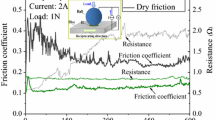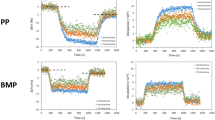Abstract
Real-time external alteration of the internal properties of lubricants is highly desirable in all mechanical systems. However, fabricating a suitable and effective smart lubricant is a long-lasting experimental process. In this study, the film thickness and frictional response of ionic liquid-lubricated non-conformal contacts to an electric field excitation under elastohydrodynamic conditions were examined. Film thickness was evaluated using a “ball-on-disc” optical tribometer with an electric circuit. Friction tests were carried on a mini traction machine (MTM) tribometer with a “ball-on-disc” rotation module and an electric circuit for contact area excitation. The results demonstrate that there is a difference in the behaviour of the ionic liquid during electric field excitation at the evaluated film thicknesses. The results of evaluated film thicknesses demonstrate that there is a difference in the behaviour of the ionic liquid during electric field excitation. Therefore, the ionic liquids could be a new basis for the smart lubrication of mechanical components. Moreover, the proposed experimental approach can be used to identify electrosensitive fluids.
Article PDF
Similar content being viewed by others
Avoid common mistakes on your manuscript.
References
Stanway R. Smart fluids: Current and future developments. Mater Sci Technol20(8): 931–939 (2004)
Michalec M, Svoboda P, Krupka I, Hartl M. Tribological behaviour of smart fluids influenced by magnetic and electric field-A review. Tribol Ind40(4): 515–528 (2018)
Matsumura Y, Shiraishi T, Morishita S. Stiffness and damping of liquid crystal lubricating film under electric field. Tribol Int54: 32–37 (2012)
Xie G X, Luo J B, Guo D, Liu S H. Nanoconfined ionic liquids under electric fields. Appl Phys Lett96(4): 043112 (2010)
Dupont J, De Souza R F, Suarez P A Z. Ionic liquid (molten salt) phase organometallic catalysis. Chem Rev102(10): 3667–3692 (2002)
Lei Z G, Chen B H, Koo Y M, MacFarlane D R. Introduction: Ionic liquids. Chem Rev117(10): 6633–6635 (2017)
Ngo H L, LeCompte K, Hargens L, McEwen A B. Thermal properties of imidazolium ionic liquids. Thermochim Acta357–358: 97–102 (2000)
Jacquemin J, Husson P, Padua A A H, Majer V. Density and viscosity of several pure and water-saturated ionic liquids. Green Chem8(2): 172–180 (2006)
Gao M, Ma L R, Luo J B. Effect of alkyl chain length on the orientational behavior of liquid crystals nano-film. Tribol Lett62(2): 24 (2016)
Xue L J, Gurung E, Tamas G, Koh Y P, Shadeck M, Simon S L, Maroncelli M, Quitevis E L. Effect of alkyl chain branching on physicochemical properties of imidazolium-based ionic liquids. J Chem Eng Data61(3): 1078–1091 (2016)
Minami I. Ionic liquids in tribology. Molecules14(6): 2286–2305 (2009)
Bermúdez M D, Jiménez A E, Sanes J, Carrión F J. Ionic liquids as advanced lubricant fluids. Molecules14(8): 2888–2908 (2009)
Zhou F, Liang Y M, Liu W M. Ionic liquid lubricants: Designed chemistry for engineering applications. Chem Soc Rev38(9): 2590–2599 (2009)
Zhou Y, Qu J. Ionic liquids as lubricant additives: A review. ACS Appl Mater Interfaces9(4): 3209–3222 (2017)
Xiao H P. Ionic liquid lubricants: Basics and applications. Tribol Trans60(1): 20–30 (2017)
English N J, Mooney D A, O’Brien S. Ionic liquids in external electric and electromagnetic fields: A molecular dynamics study. Mol Phys109(4): 625–638 (2011)
Fajardo O Y, Bresme F, Kornyshev A A, Urbakh M. Electrotunable lubricity with ionic liquid nanoscale films. Sci Rep5: 7698 (2015)
David A, Fajardo O Y, Kornyshev A A, Urbakh M, Bresme F. Electrotunable lubricity with ionic liquids: The influence of nanoscale roughness. Faraday Discuss199: 279–297 (2017)
Huang W, Kong L L, Wang X L. Electrical sliding friction lubricated with ionic liquids. Tribol Lett65(1): 17 (2017)
Xie G X, Si L N, Guo D, Liu S H, Luo J B. Interface characteristics of thin liquid films in a charged lubricated contact. Surf Interface Anal47(3): 315–324 (2015)
Somers A E, Howlett P C, MacFarlane D R, Forsyth M. A review of ionic liquid lubricants. Lubricants1(1): 3–21 (2013)
Cooper P K, Li H, Rutland M W, Webber G B, Atkin R. Tribotronic control of friction in oil-based lubricants with ionic liquid additives. Phys Chem Chem Phys18(34): 23657–23662 (2016)
Hoth J, Hausen F, Müser M H, Bennewitz R. Force microscopy of layering and friction in an ionic liquid. J Phys: Condens Matter26(28): 284110 (2014)
Hamrock B J, Dowson D. Isothermal elastohydrodynamic lubrication of point contacts: Part III—fully flooded results. J Lubr Technol99(2): 264–275 (1977)
Hartl M, Krupka T, Poliščuk R, Liška M, Molimard J, Querry M, Vergne P. Thin film colorimetric interferometry. Tribology Transactions44(2): 270–276 (2001)
Stribeck R. Die wesentlichen Eigenschaften der Gleit- und Rollenlager. Berlin (Germany): Springer, 1903.
Abbott A P, Frisch G, Hartley J, Karim W O, Ryder K S. Anodic dissolution of metals in ionic liquids. Prog Nat Sci: Mater Int25(6): 525–602 (2015)
Abbott A P, Capper G, Davies D L, Rasheed R K, Archer J, John C. Electrodeposition of chromium black from ionic liquids. Trans IMF82(1–2): 14–17 (2004)
Totolin V, Pisarova L, Dörr N, Minami I. Tribochemistry and thermo-oxidative stability of halogen-free ionic liquids. RSC Adv7(77): 48766–48776 (2017)
Pivnic K, Fajardo O Y, Bresme F, Kornyshev A A, Urbakh M. Mechanisms of electrotunable friction in friction force microscopy experiments with ionic liquids. J Phys Chem C122(9): 5004–5012 (2018)
Perkin S. Ionic liquids in confined geometries. Phys Chem Chem Phys14(15): 5052–5062 (2012)
Zhang F, Xie G X, Pan J S. Tunable adsorption and film formation of mussel adhesive protein by potential control. Langmuir33(35): 8749–8756 (2017)
Fajardo O Y, Bresme F, Kornyshev A A, Urbakh M. Electrotunable friction with ionic liquid lubricants: How important is the molecular structure of the ions? J Phys Chem Lett6(20): 3998–4004 (2015)
Kong L L, Huang W, Wang X L. Ionic liquid lubrication at electrified interfaces. J Phys D: Appl Phys49(22): 225301 (2016)
Acknowledgements
This research was carried out under the CEITEC 2020 project (LQ1601) with financial support from the Ministry of Education, Youth and Sports of the Czech Republic under the National Sustainability Programme II and the project FSI-S-17-4415 with financial support from the Ministry of Education, Youth and Sports of the Czech Republic. Aleksandar VENCL acknowledges the projects TR 34028 and TR 35021, financially supported by the Republic of Serbia, Ministry of Education, Science and Technological Development.
Author information
Authors and Affiliations
Corresponding author
Additional information
Michal MICHALEC. He received his M.S. degree in mechanical engineering from Brno University of Technology, Czech Republic, in 2019. His current position is a junior researcher and a member of Elastohydrodynamic Lubrication Section at Tribology Group, Institute of Machine and Industrial Design, Faculty of Mechanical Engineering, Brno University of Technology. His research areas cover the boundary, mixed, and elastohydrodynamic lubrication, rheology of ionic liquids, friction, and wear.
Petr SVOBODA. He received his M.S. and Ph.D. degrees in mechanical engineering from Brno University of Technology, Czech Republic, in 2005 and 2009, respectively. His current position is an associate professor and a member of Elastohydrodynamic Lubrication Section at Tribology Group, Institute of Machine and Industrial Design, Faculty of Mechanical Engineering, Brno University of Technology. His research areas cover the boundary, mixed, and elastohydrodynamic lubrication, starvation, surface texturing effect, and lubricant rheology.
Ivan KRUPKA. He received his M.S. and Ph.D. degrees in mechanical engineering from Brno University of Technology, Czech Republic, in 1990 and 1997, respectively. His current position is a professor and head of Tribology Group, Institute of Machine and Industrial Design, Faculty of Mechanical Engineering, Brno University of Technology. His research areas cover the mixed and elastohydrodynamic lubrication, surface texturing effect, and lubricant rheology.
Martin HARTL. He received his M.S. and Ph.D. degrees in mechanical engineering from Brno University of Technology, Czech Republic, in 1990 and 1997, respectively. His current position is a professor and head of Institute of Machine and Industrial Design, Faculty of Mechanical Engineering, Brno University of Technology. His research areas cover the boundary, mixed, and elastohydrodynamic lubrication, roughness effect, and biotribology.
Aleksandar VENCL. He received his M.S. degree in engineering materials in 2002 and Ph.D. degree in tribology in 2008 from the Faculty of Mechanical Engineering at University of Belgrade, Republic of Serbia. His current position is a full professor and head of Tribology Laboratory at Faculty of Mechanical Engineering, University of Belgrade. His main research fields are friction and wear characteristics of materials (metals, polymers, ceramics, and composites), surface modifications and coatings, lubricants (application, recycling, and monitoring), nanotribology, and failure diagnostic of tribological systems.
Rights and permissions
Open Access This article is licensed under a Creative Commons Attribution 4.0 International License, which permits use, sharing, adaptation, distribution and reproduction in any medium or format, as long as you give appropriate credit to the original author(s) and the source, provide a link to the Creative Commons licence, and indicate if changes were made.
The images or other third party material in this article are included in the article’s Creative Commons licence, unless indicated otherwise in a credit line to the material. If material is not included in the article’s Creative Commons licence and your intended use is not permitted by statutory regulation or exceeds the permitted use, you will need to obtain permission directly from the copyright holder.
To view a copy of this licence, visit http://creativecommons.org/licenses/by/4.0/.
About this article
Cite this article
Michalec, M., Svoboda, P., Krupka, I. et al. Investigation of the tribological performance of ionic liquids in non-conformal EHL contacts under electric field activation. Friction 8, 982–994 (2020). https://doi.org/10.1007/s40544-019-0342-y
Received:
Revised:
Accepted:
Published:
Issue Date:
DOI: https://doi.org/10.1007/s40544-019-0342-y




